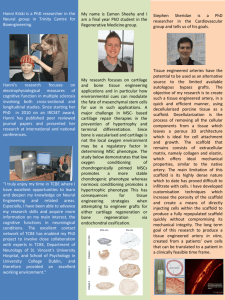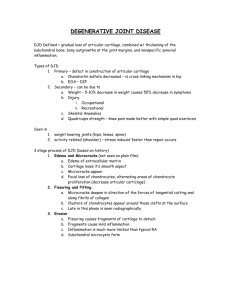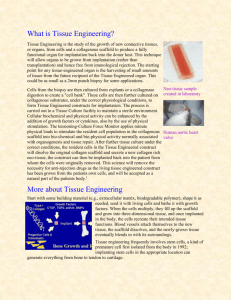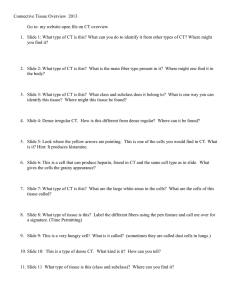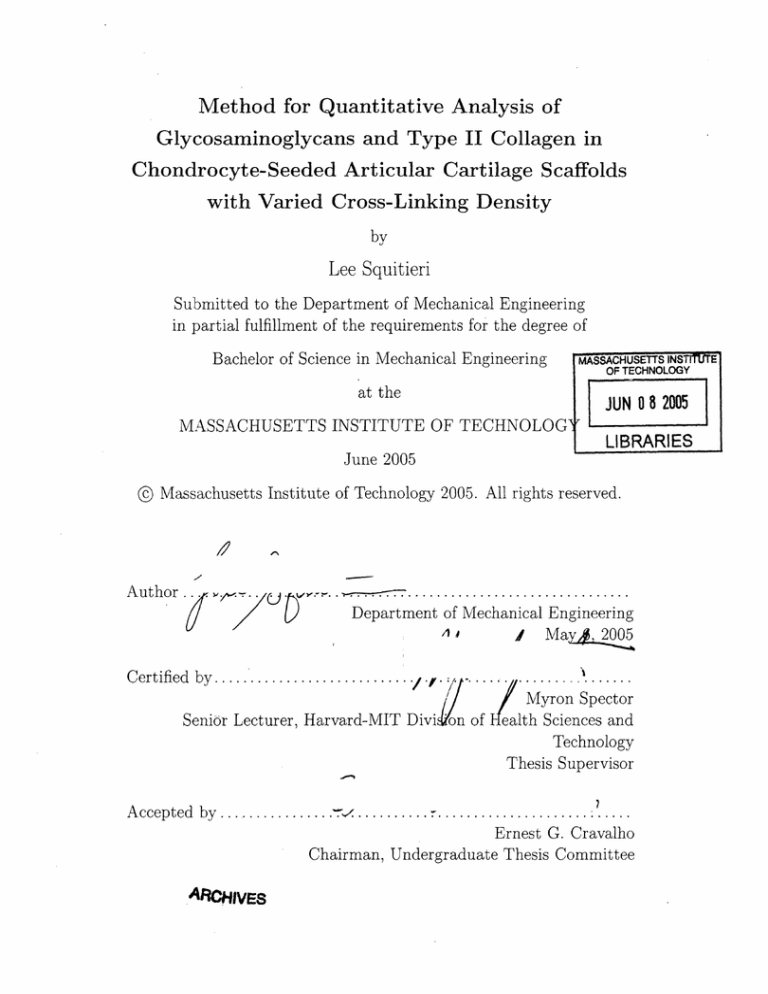
Method for Quantitative Analysis of
Glycosaminoglycans and Type II Collagen in
Chondrocyte-Seeded Articular Cartilage Scaffolds
with Varied Cross-Linking Density
by
Lee Squitieri
Submitted to the Department of Mechanical Engineering
in partial fulfillment of the requirements for the degree of
Bachelor of Science in Mechanical Engineering
MASSACHUSETTS INS! IE
OF TECHNOLOGY
at the
JUN 0 8 2005
MASSACHUSETTS INSTITUTE OF TECHNOLOG
LiRARIES
LIBRARIES
June 2005
(
Massachusetts Institute of Technology 2005. All rights reserved.
6
Author..;>;.. C
7..
.................................
of Mechanical Engineering
L'/Department
/X Ma x42005
Certifiedby............
................ I '/ i/.
o.
.
.
o.
.
..
.
.
.
.
.
.
.
Myron Spector
Senior Lecturer, Harvard-MIT Diviion of Health Sciences and
Technology
Thesis Supervisor
by............................. .......................
Accepted
....
Ernest G. Cravalho
Chairman, Undergraduate Thesis Committee
ARCHIVES
2
Method for Quantitative Analysis of Glycosaminoglycans
and Type II Collagen in Chondrocyte-Seeded Articular
Cartilage Scaffolds with Varied Cross-Linking Density
by
Lee Squitieri
Submitted to the Department of Mechanical Engineering
on May 6, 2005, in partial fulfillment of the
requirements for the degree of
Bachelor of Science in Mechanical Engineering
Abstract
Articular cartilage tissue engineering is a useful tool to study and enhance the wound
healing processes of articular cartilage in vivo. Current tissue engineering scaffolds for
articular cartilage are produced by cross-linking type II collagen with glycosamino-
glycans (GAG), creating pores in the resulting construct, and then seeding these
pores with chondrocytes (articular cartilage producing cells). However, little information is known regarding the effect of cross-linking on the composition of the tissue
that is produced by the chondrocytes, i.e. the relative quantity of GAG and type II
collagen produced. In this study, I describe a method for the quantitative analysis
of glycosaminoglycans in chondrocyte-seeded articular cartilage scaffolds with varied
cross-linking density. Unlike other methods for determining GAG content, which digest the tissue sample (DMMB assay), my methodology accurately assesses the GAG
content in stained histological tissue sections, therefore allowing the researcher to
study tissue morphology. After identifying a parameter to quantify the intensity of
red color in the tissue sections, the method was applied to the quantification of GAG
distribution in samples of natural and engineered cartilage cultured for two weeks in
vitro. These values were then compared with biochemically determined values for va-
lidity. In conclusion, this study has demonstrated the utilization of image processing
techniques to consistently produce quantitative values for the determination of GAG
in Safranin-O stained histological tissue sections. Future work may expand and adapt
this protocol for the quantification and spatial determination of other types of stains,
such as the immunohistochemical
staining procedure for type II collagen.
Thesis Supervisor: Myron Spector
Title: Senior Lecturer, Harvard-MIT
Division of Health Sciences and Technology
3
4
Chapter
1
Background and Introduction
Articular cartilage is a specialized type of elastic connective tissue that covers the ends
of bones in diarthrodial
joints. Its main function is to provide a low-friction load-
bearing surface, therefore enabling the bones to move smoothly over one another
during joint motion[5, 3, 4]. When damaged, either by trauma, disease, or chronic
mechanical loading, articular cartilage has a distinctively low healing capacity[4]. The
low cell density and low cell mitotic activity of articular cartilage limit the ability of
chondrocytes to reproduce and repair wounded tissue. In addition, the avascularity
of articular cartilage prevents the development of a fibrin clot, which is necessary for
cell migration and attachment to begin the repair process[3].
Depending on the size and location, small, untreated defects in articular cartilage continue to degenerate and expand[5, 4]. The resulting breakdown of articular
cartilage can lead to pain, swelling, minor loss of joint function, and in the worst
case, profound disability[4]. Several surgical procedures aimed at repairing damaged
articular cartilage have been reported to relieve symptoms of pain and dysfunction.
However, none have achieved the desired regeneration of native cartilage over the long
term [5].
Recently, studies have indicated the potential solution of tissue engineering methods to repair and regenerate defected articular cartilage. Tissue engineering employs
cells, scaffolds, and chemical or mechanical regulators, alone or in combination, in an
attempt to restore the structure and function of damaged tissue[6, 5]. Previously, for
5
articular cartilage, our lab has employed a scaffold base consisting of type II collagen cross-linked with glycosaminoglycans (GAG) [5]. Cross-linking involves covalently
linking the chains of two polymers to enhance their combined material properties,
because the resulting network is stronger and more resistant to degradation: crosslinking directly affects the stiffness/strength
of the base scaffold and has been proven
to deter the onset of contraction and promote regeneration in other organs, such as
skin[6]. This base is then made porous and seeded with chondrocytes, which, when
allowed to grow in proper medium, produce engineered tissue[6, 5].
Previously, Lee et al. have shown that culturing a chondrocyte-seeded
collagen-GAG scaffold for 4 weeks in vitro prior to implantation
type II
is more effective
(i.e. produces more reparative tissue with greater percentage of hyaline cartilage)
than culturing for only 12 hrs prior to implantation[2].
However, while a significant
amount of tissue was synthesized in the constructs during the 4 week in vitro culture
period, the engineered tissue contained a low cell density, low type II collagen and
low proteoglycan content[2]. It has been hypothesized that a construct with a higher
collagen and proteoglycan content, cell density, and biosynthesis rates closer to that of
mature articular cartilage will result in improved regeneration (i.e. greater amounts
of hyaline cartilage) of articular cartilage defects in vivo[5].
However, little information is known regarding the effect of cross-linking on the
composition of the tissue that is produced by the chondrocytes, i.e. the relative
percent of glycosaminoglycans and type II collagen produced. Therefore, quantitative analysis regarding the relationship of cross-link density and the composition
of regenerated articular cartilage in engineered chondrocyte-seeded tissue scaffolds
is necessary for improving the quality of articular cartilage tissue engineering and
clinical research.
6
Chapter 2
Objective and Design Component
The objective/design element of my thesis project is to determine a method for the
quantitative analysis of glycosaminoglycans and type II collagen in stained histological sections of chondrocyte-seeded
articular cartilage scaffolds with varied cross-link
density. Current alternative methods of quantifying GAG (by DMMB assay) and
type II collagen (Western Blotting) require the digestion of the tissue or cell-seeded
scaffold[l]. Therefore, histology cannot be performed and subsequently tissue morphology cannot be determined. This method will allow us to quantitatively compare
histological sections. The development of this tool for quantitative analysis will not
only be useful in comparing scaffolds with varied cross-linking density but will also
be useful for the measuring the development and composition of engineered cartilage
in various matrix configurations over time.
7
8
Chapter 3
Materials and Methods
3.1
Mlaterials and Tissue Culture
Prior to my involvement with this project, four types of scaffolds (DHT, EDAC1,
EDAC2, EDAC3) with varied cross-linking density (least to greatest, respectively)
were produced under uniform conditions. The scaffolds were fabricated by freezedrying a porcine-derived type II collagen-GAG slurry (Geistlich Biomaterials, Switzerland) to form sheets approximately
2.5mm thick. Disks 8mm in diameter cut from
the porous sheets were sterilized and cross-linked by dehydrothermal treatment under
a vacuum (50mTorr) and temperature
of 105C for 24 hours. Further cross-linking was
achieved by treatment with a water-soluble carbodiimide. Four groups of scaffolds
were established, each with significantly different swelling ratios, and hence differ-
ent cross-link densities. Relative cross-link densities of the scaffolds were determined
indirectly by means of their swelling ratios.
Chondrocytes were then obtained from the knee joints of one adult mongrel dog
immediately postmortem, and cultured to reproduce. Cells from the first sub-culture
were collected just prior to confluence and the same suspension concentration was
seeded into each of the four types of collagen II-GAG scaffolds.
The cell-seeded
matrices were then cultured in 24-well plates coated with lml of 2% agarose (to
prevent cells from attaching to the bottom of the culture dish) for 2 weeks.
9
3.2
Biochemical and Histological Processing
The chondrocyte-seeded
matrices were fixed in 10-% formalin for a minimum of 3
days prior to processing and embedding in paraffin for microtomy. Specimens cut to
7 m thickness were mounted on glass slides and stained with Safranin-O or antibody
to type II collagen using standard histological techniques.
3.2.1
Safranin-O Staining Procedure
My role in this project began with the quantitative determination of glycosaminoglycans. For this, I used Safranin-O a cationic dye that produces a bright red color
when bound to the net negative charge of sulfated glycosaminoglycans on the tissue sections [Fig. 1A]. Slides were deparaffinized and rehydrated through successive
washes with xylene (2 x 5min), 100% EtOH (2 x 3min), 95% EtOH (2 x 2 min), 80%
EtOH (1 x min), and tap water (2 x 5min). Next slides were dipped 3 quick times
in fast green and then 3 quick times in 0.5% acetic acid. Slides were then soaked in
Safranin-O (0.2% w/v) for 30 minutes. Following incubation with Safranin-O, slides
were then dehydrated through a series of washes with 95% EtOH (a few quick dips),
100% EtOHI (2 x 3 min), and xylene (2 x 3min). Upon completion of dehydration,
slides were coated with cytoseal and sealed with a coverslip. Using the Safranin-O
stained slides, I adapted an image processing protocol from Martin et al to quantify
the amount of GAG present in each tissue section.
3.2.2 Immunohistochemistry Procedure
For the quantitative
determination
of type II collagen, I used the DAKO immuno-
histochemistry kit for type II collagen and DAKO autostainer (DAKOCytomation,
Carpinteria CA). Immunohistochemistry uses specific antibodies to test for the presence of specific proteins (type II collagen), and produces a distinct color when bound
[Fig. 1B]. First, slides were rinsed and then digested with protease (0.01g Protease
XIV in 10mL TBS) for 40min to unmask the antigenic sites on each tissue section.
After another rinse, slides were quenched with peroxidase (3% hydrogen peroxidase
10
'Lt~hs
Figure 3-1: Safrinin-O stained section (A); Immunohistochemically stained section
(B)
from DAKO()kit) for 10min. Next, slides were rinsed and then blocked with a nonspecific binder (0.5mL of 5% horse serum in 10mL TBS) for 30min. Then, with rinses
inbetween each step, the slides were treated with primary antibody (1:20 dilution) or
negative control for 10min, secondary antibody (biotinylated link) for 10 min, and
tertiary reagent (streptavidin HRP) for 10min. Slides were then rinsed and incubated
with a substrate-chromogen solution (1 drop DAB Chromogen per lmL buffered substrate) for 10min. Next, slides were removed from the autostainer
and washed with
dH20 (3min) and then incubated with filtered hematoxylin (3min). Then slides were
soaked in
H20 (3min) and then dipped a few quick times in acid alcohol (lmL
HCl in 99mL 80% ethanol). After a subsequent wash with dH20 (3min), slides were
dehydrated
through successive washes in xylene ( 3min), 80% EtOH (a few dips),
95% EtOH (a few dips), 100% EtOH (1 min), and xylene.
Once dehydration was
complete, the slides were coated with cytoseal and sealed with a coverslip.
3.3
Image Processing
Low magnification images of the whole cross sections of tissue samples were acquired
using a MicroFire Model S99809 camera (Meyer Instruments, Houston TX) mounted
on an Olympus BX51 microscope (Olympus, Japan) with a 4X objective. Images were
11
exposed to the light source from the microscope in addition to the ambient light.
PictureFrame (Optronics, Goleta CA) was used to capture uniform images (1600
X 1200 pixels), and Image J (NIH, Bethesda MD) was used to uniformly crop the
images (1280 X 960 pixels). Using Image J, images were normalized by subtracting
a background image, acquired with the same light intensity, and by inverting the
resulting negative image. For each image, the tissue section was identified as the area
that was significantly darker than the background. Next, the identified tissue section
of each image was selected and the background cleared. The resulting image was then
split into red, green, and blue (RGB) image planes in a scale of 255 values (black=0).
For each image, the red, green, and blue planes were exported as text files and
then individually imported into Matlab (Mathworks, Natick MA) [Appendix A]. In
order to define a parameter that could be used to measure the quantitative intensity
of red in each image, the RGB planes were examined as follows. The fraction of red
(RF) was dlefined as the ratio of the R component to the sum of the R, G, and B
components: RF = R/(R + G + B). RF, which is a measure of the perception of
red in a color image, was then normalized to RF,N according to the equation: RF,N
= 1.5*RF - 0.5 as given by Martin et al[2]. The normalization of RF to RF,N was
necessary to reduce the RC values in non-red bright areas, in which all components
(R, G, B) are all high. RF,N was set to 0 if the R component was not the dominant
fraction, or if the pixel was determined to be white (i.e. the sum of R+B+G
greater than 675). Next, the red concentration
was
(RC) of each red-dominant pixel was
calculated as RC = R*RF,N (i.e proportional to both the brightness of the red and
the normalized fraction of red color). The average red content of the whole tissue
section (RAVG) was calculated as the average RC value of all non-white pixels in
which R was the dominant fraction.
Statistical significance of the glycosaminoglycan
measurements
was assessed by
analysis of variance (ANOVA).
Once the color intensity of the Saf-O stained slides was determined and verified,
I attempted to use a similarly adapted protocol to quantify the amount of type II
collagen in immunohisotochemically stained slides taken from the same construct
12
and prepared under the same conditions. However, due to the purplish color of the
hematoxylin stained nuclei I was unable to collect any objective quantitative data.
13
14
Chapter 4
Results
Previously, Martin et al. validated the methodology of calculating the average intensity of color assed by image analysis (RTOT) by confirming its linear relationship
with the biochemically (% ww) determined values[2]. The same principle was used
in this study to validate my methodology. GAG distribution was studied in cartilage
explants and cell-seeded engineered constructs with varied cross-link density, cultured
for 2 weeks. The average red content (RAVG) of each tissue section was calculated
[Appendix 13].From these initial values the average red content for each scaffold type
was determined(Table 4.1 and Figure 4-1). DHT, EDAC1, EDAC2, and EDAC3
represent the four different types of chondrocyte-seeded
scaffolds with varied cross-
link density (least to greatest, respectively). Their average red content values as a
percentage of the red content of native cartilage controls can be seen in Table 4.2.
lstandard deviation
standard error of the mean
2
Scaffold Type
DHT
EDAC1
Average Red Content
47.7
45.0
STDEV 1
15.0
4.37
SEM 2
4.3
1.2
EDAC2
EDAC3
10.1
11.4
5.8
1.6
1.6
0.6
Native Articular Cartilage
64.1
14.2
4.3
Table 4.1: Average red content for each scaffold type
15
Scaffold Type
Normalized Red Content
STDEV
DHT
EDAC1
74.46%
70.31%
23.42
6.86
EDAC2
15.89%
9.1
EDAC3
17.79%
2.65
Table 4.2: Red content normalized to red content of native cartilage
60
50
40
0
0 30
C.)
C 20
10
0
DHT-
EDAC2
EDAC1
EDAC3
Group
Figure 4-1: Average red content in each scaffold type
To validate our method, the average red content value for each scaffold was com-
pared with its corresponding previously determined GAG density (m/mm
DMMB assay 4-2. GAG density (m/rmm
3
3)
using
) was calculated by dividing the mass of
GAG from the DMMB assay by an estimated volume[1].
Prior statistical analysis of the DMMB assay revealed no statistically significant
difference between the EDAC2 and EDAC3 scaffold groups. However, there was an
observed statistically
significant difference between the DHT and EDAC1 scaffold
groups.
The red content values were analyzed using StatView (StatView Software, Cary
NC). Analysis of variance (ANOVA) was run to determine whether the observed
differences in average red content between scaffold types were statistically significant.
The results can be seen in Figure 4-3
16
12
.... .......
................
.....................
10
E
8
. T
. .
...
6
0
'..
co
E
C
4
©2 2
..
i
,
.
I
.
DHT
..
.
^vv~ ev
I
_. ..
.
:/:.
.
. v.¢m
.-. W
.
__F
.X._
.
I
~
I
ZC
EDAC1
:.:
.4~~~~~~~~~~~~~~~~~~~~~~~~~~~~
~'. ·
' ' ,:
..
I .
1,
0
:..
77
;:::
C3
.
ECAC2
EDAC3
Group
Figure 4-2: GAG density
ANOVA Table for red content
DF Sum of Squares
group
13446.615
Residual
39
Mean Square
F- ' Value
4482.205
5 6.338
3102.815
P-Value
Lambda
Power
<.0001 169.014
1.000
79.559
Fisher's PLSDfor red content
Effect: group
Significance Level: 5 %
Mean Diff. Crit. Diff.
DHT, EDAC1
2.662
7.222
P-Value
.4604
DHI-f,EDAC2
37.570
7.365
<.0001
S
DHT, EDAC3
36.349
9.021
<.0001
S
EDAC1,EDAC2
34.907
7.222
<.0001 S
EDAC1,EDAC3
33.687
8.904
<.0001
EDAC2, EDAC3
-1.221
9.021
.7858
S
Figure 4-3: Analysis of variance for average red content values
17
18
Chapter 5
Discussion
In this study, I have created a protocol for the accurate quantification of GAG in
stained histological sections of cartilaginous tissues. Unlike other current methods,
this protocol does not require the digestion of the tissue samples and allows researches
to quantitatively compare histological sections. The parameter RAVG derived from
the proposed image processing technique is proportional to the intensity of red in
Safranin-O stained sections, and therefore the fixed charge density of the tissue. However, it is important to consider the varied relationship between fixed charge density
and GAG content in the tissue section. Since different types of GAG have a different
number of charges per mass of disaccharide, this method may only be used as an ap-
proximation of the relative GAG content in stained histological tissue sections[2]. In
addition, the sensitivity of GAG estimation to specific staining conditions such as pH,
exposure time, and concentration, further limits this protocol to relative comparison
between tissue sections (prepared under the same conditions), rather than absolute
quantification[2].
Validation of my method was achieved by comparing the image processing values
with previously determined GAG densities from the same tissue constructs. Both
the GAG density data and the image processing data show a statistically significant
difference between the DHT/EDAC1 scaffolds and the EDAC2/EDAC3 scaffolds,
and no difference between the EDAC2 and EDAC3 scaffolds. However, while the
GAG density data showed a significant difference between the DHT and EDAC1
19
scaffolds, the image processing data did not. One possible reason for this discrepancy
is the potential inaccuracy of the GAG density calculation. Even if the DMMB assay
yielded an accurate measure of the mass of GAG in the sample, inaccuracies in the
estimated volume would still lead to density miscalculations. Another more probable
source of data inconsistency results from the variation between the sections analyzed
in the DMMB assay and the image processing technique. Whereas the DMMB assay
analyzed the entire scaffold (post digestion), the image processing technique analyzed
single, very thin sections of the scaffold[l]. It is possible that the unanalyzed sections
of the DHT scaffolds contained more GAG, or that the unanalyzed sections of the
EDAC1 scaffolds contained less GAG. In other words, the slides analyzed by the
image processing technique may not have been representative
of the entire scaffold.
In spite of the above limitations, this study has demonstrated the utilization of
image processing techniques to consistently produce quantitative values for the determination
of GAG in Safranin-O stained histological tissue sections. However, this
technique failed to accurately quantify the amount of type II collagen in the immunohistochemically stained slides. The main reason for this inaccuracy was the presence
of hematoxylin-stained
bound antibody.
quantification
nuclei on the immuno-stained slides and the brown color of the
Since brown contains a red, green, and blue component, my GAG
protocol would not work (since it only calculated red intensity).
In
addition, the presence of the purplish colored nuclei biased any quantitative data by
yielding higher color intensity for tissue sections with higher cell density (i.e. greater
numbers of nuclei). Therefore, the protocol developed in this study and the immunohistochemical staining method need to be further modified in order to obtain a valid
quantitative
methodology for type II collagen.
The work presented in this study could be extended in several directions. Future
studies may want to further test the GAG image processing technique by performing
quantitative
analysis of all sections for a given scaffold, rather than only a few sec-
tions. This would provide a more comprehensive average red content (RAVG) value
for comparison with the DMMB GAG densities.
Image processing analysis of an
entire scaffold could also be used to study the spatial patterns of GAG distribution
20
throughout native cartilage and engineered constructs over time. Alternatively, this
protocol could be expanded and modified to determine the relative quantity of type
II collagen in native cartilage and engineered constructs. If the hematoxylin-stained
nuclei were eliminated from the slides, and the protocol was adapted to calculate
grayscale itensity
(as a measure of brown color), the developed image processing
protocol could be accurately adapted and normalized to quantify type II collagen in
stained histological tissue sections.
21
22
Appendix A
23
1 % image processing saf-o
g=green; b=blue;
2 % r=red;
3
adds red, green, and blue components
4 sum=r+g+b;
redfrac=r./sum; % calc. the red fraction
21
27 % matlab rotates image so that length and width are reversed
enter image pixel length
8 WIDTH=960;
29
30
LENGTH=1280;
% enter image pixel width
11
i=l;
set up loop to calc "red content" for each pixel of image
(i<=VIDTH)
j=l.;
jC(j<=LENGTH)
15
% only include non-white pixels in which red is dominant
1i~
((redfrac(i,j)
>= .3333) & (sum(i,j) c<675))
rednorm(i,j)=l.5.*tredfrac(i,j)-0.5; % normalized red fraction
18|
redconc(i,j)=rednorm(i,j).tr(i,j);
% calc. "red content" of each pixel
1I
% set "red content" of pixel to zero if red not dominant or if white
12
1v 13
14
15i
1B
17
18
19
20
21
redconc (i,j) =0;
2
23
24
j=j+l;
25
i=i+l;
% close loop
26
up loop to calc. total "red content" of image (i.e. add all pixel values)
28 i=l; % set ti
'29
30
31
totalredconc=0;
(i<=WIDTH)
j=l;
(j<=LENGTH)
32
33
34
35i
36
37
38
39
% tally up "red content" of each pixel
totalredconc=redconc (i,j )+totalredconc;
j=j+l;
i=i.+l;
% close loop
-
totalredconc
40
output total "red content" of entire image
41
finds
42 zerofind=find(redconc==0);
[rows,
columns]=size(zerofind);
43
# of pixels in which "red content" equals zero
numzeros=rowst columns;
44
45
46 numzeros % output # of pixels in which "red
content"
equals
zero
47
%calc. total
48 totalnum=WIDTHtLENGTH-numzeros;
49 totalnum %output # of red dominant pixels
50
# of red dominant pixels
51
avgredconc=totalredconc/totalnum;
52
avgredconc % output avg. "red content' per red dominant pixel
calc. avg. "red content" per red dominant pixel
I
Figure A-1: Matlab Code for Safrinin-O Quantification
24
Appendix B
25
Scaffold or Cartilage Type
DHT
EDAC1
EDAC2
EDAC3
Native Cartilage Control 1
Tissue Section ID
Average Red Content
151-04a
151-04b
151-04c
151-04d
152-04a
152-04b
152-04c
152-04d
153-04a
153-04b
153-04c
153-04d
154-04a
154-04b
154-04c
154-04d
155-04a
155-04b
155-04c
155-04d
155-04e
156-04a
156-04b
156-04c
156-04d
157-04a
157-04b
157-04c
157-04d
158-04a
158-04b
158-04c
158-04d
159-04a
159-04b
159-04c
159-04d
160-04a
160-04b
160-04c
161-04a
161-04b
161-04c
25.79
31.57
29.90
28.73
67.70
64.12
59.85
57.43
45.24
57.05
54.59
51.13
40.79
42.52
36.71
51.65
46.06
44.50
40.53
46.34
42.98
49.45
51.26
45.47
48.02
4.01
4.47
6.80
9.87
18.74
11.56
11.47
24.00
8.85
8.40
6.56
7.53
14.57
10.62
10.60
12.15
10.24
10.28
70.51
79.53
56.52
79.00
79.90
69.70
64.48
61.38
53.13
31.74
59.62
5412Pla
5412Plb
5412Plc
5412P8a
5412P8b
5412P8c
Native Cartilage Control 2
5435Pla
5435Plb
5435P5a
5435P5b
5435P5c
Table B.1: Average red content for all tissue sections
Appendix C
Directions
Image J Analysis
(must save images as .tif files to avoid image degradation during
processing)
* Open image in Image J
* Open background image in Image J
* Under the "Process" toolbar choose "Image Calculator"
* Calculate the "Difference" between the image and the background image
=
resulting image should be color inverted
* Under the "Edit" toolbar choose "Invert" > reverts the image back to normal
color distribution
* Under the "Image" toolbar choose "Color" and then "RGB split" =>this should
split the image into three grayscale images (one representing the red component,
one representing the blue component, and one representing the green component)
* For each color component image: under "File" toolbar choose "Save As" and
then "Text Image"
27
Loading Text Image into Matlab
(will reverse image pixel width and length)
* Under the "File" toolbar choose "Import Data"
* Highlight the red, blue, and green text files saved under Image J (one at a time)
* Run the Matlab code in Appendix A
Bibliography
[1] R. W. Farndale, D. J. Buttle, and A. J. Barrett. Improved quantitation and
discrimination of sulphated glycosaminoglycans by use of dimethylmethylene
blue.
Biochim Biophys Acta, 1986.
[2] C. R. Lee, A. J. Grodzinsky, and M. Spector. Biosynthetic response of passaged
chondrocytes in a type ii collagen scaffold to mechanical compression. J Biomed
Mater Res, 2003.
[3] I. Martin, B. Obradovic, L. E. Freed, and G. Vunjak-Novakovic.
Method for
quantitative analysis of glycosaminoglycan distribution in cultured natural and
engineered cartilage. Ann Biomed Eng, 1999.
[4] Capito M. Ramille and Myron Spector. Scaffold-based articular cartilage repair:
future prospects wedding gene therapy and tissue engineering. IEEE Eng Med
Bio Mag, 2003.
[5] Myron Spector. Joints: Regeneration of bone, cartilage, meniscus, ligaments, and
tendon. MIT, Unpublished Article.
[6] Scott Vickers. Development of a type II collagen-glycosaminoglycanimplant for articular cartilage regeneration. PhD thesis, Massachusetts Institute of Technology,
2005.
29




